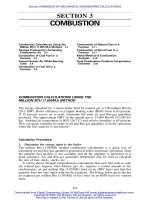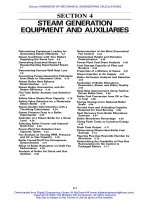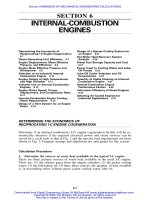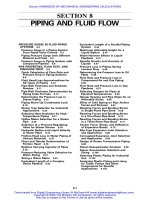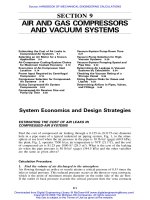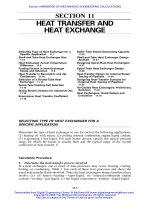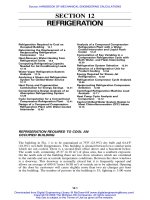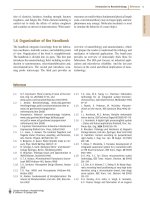Tài liệu Handbook of Corrosion Engineering P2 pdf
Bạn đang xem bản rút gọn của tài liệu. Xem và tải ngay bản đầy đủ của tài liệu tại đây (295.42 KB, 20 trang )
Practical experience related to boiler corrosion kinetics at different
feedwater pH levels is included in Fig. 1.5. The kinetic information in
Fig. 1.5 indicates that high oxygen contents are generally undesirable.
It should also be noted from Figs. 1.5 and 1.6 that active corrosion is
possible in acidified untreated boiler water, even in the absence of oxy-
gen. Below the hydrogen evolution line, hydrogen evolution is thermo-
dynamically favored as the cathodic half-cell reaction, as indicated.
Undesirable water acidification can result from contamination by sea
salts or from residual cleaning agents.
Inspection of the kinetic data presented in Fig. 1.5 reveals a ten-
dency for localized pitting corrosion at feedwater pH levels between 6
and 10. This pH range represents a situation in between complete sur-
face coverage by protective oxide films and the absence of protective
films. Localized anodic dissolution is to be expected on a steel surface
covered by a discontinuous oxide film, with the oxide film acting as a
cathode. Another type of localized corrosion, caustic corrosion, can
occur when the pH is raised excessively on a localized scale. The E-pH
diagrams in Figs. 1.5 and 1.6 indicate the possibility of corrosion dam-
age at the high end of the pH axis, where the protective oxides are no
longer stable. Such undesirable pH excursions tend to occur in high-
temperature zones, where boiling has led to a localized caustic con-
centration. A further corrosion problem, which can arise in highly
alkaline environments, is caustic cracking, a form of stress corrosion
cracking. Examples in which such microenvironments have been
proven include seams, rivets, and boiler tube-to-tube plate joints.
Hydronic heating of buildings.
Hydronic (or hot-water) heating is used
extensively for central heating systems in buildings. Advantages over
hot-air systems include the absence of dust circulation and higher heat
efficiency (there are no heat losses from large ducts). In very simple
terms, a hydronic system could be described as a large hot-water ket-
tle with pipe attachments to circulate the hot water and radiators to
dissipate the heat.
Heating can be accomplished by burning gas or oil or by electricity.
The water usually leaves the boiler at temperatures of 80 to 90°C. Hot
water leaving the boiler passes through pipes, which carry it to the radi-
ators for heat dissipation. The heated water enters as feed, and the
cooled water leaves the radiator. Fins may be attached to the radiator to
increase the surface area for efficient heat transfer. Steel radiators, con-
structed from welded pressed steel sheets, are widely utilized in hydron-
ic heating systems. Previously, much weightier cast iron radiators were
used; these are still evident in older buildings. The hot-water piping is
usually constructed from thin-walled copper tubing or steel pipes. The
circulation system must be able to cope with the water expansion result-
22 Chapter One
0765162_Ch01_Roberge 9/1/99 2:46 Page 22
ing from heating in the boiler. An expansion tank is provided for these
purposes. A return pipe carries the cooled water from the radiators back
to the boiler. Typically, the temperature of the water in the return pipe
is 20°C lower than that of the water leaving the boiler.
An excellent detailed account of corrosion damage to steel in the hot
water flowing through the radiators and pipes has been published.
6
Given a pH range for mains water of 6.5 to 8 and the E-pH diagrams
in Figs. 1.7 (25°C) and 1.8 (85°C), it is apparent that minimal corro-
sion damage is to be expected if the corrosion potential remains below
Ϫ0.65 V (SHE). The position of the oxygen reduction line indicates
that the cathodic oxygen reduction reaction is thermodynamically very
Aqueous Corrosion 23
;;;;;;;;;;;;;;;
;;;;;;;;;;;;;;;
;;;;;;;;;;;;;;;
;;;;;;;;;;;;;;;
;;;;;;;;;;;;;;;
;;;;;;;;;;;;;;;
;;;;;;;;;;;;;;;
;;;;;;;;;;;;;;;
;;;;;;;;;;;;;;;
;;;;;;;;;;;;;;;
;;;;;;;;;;;;;;;
;;;;;;;;;;;;;;;
;;;;;;;;;;;;;;;
;;;;;;;;;;;;;;;
;;;;;;;;;;;;;;;
;;;;;;;;;;;;;;;
;;;;;;;;;;;;;;;
;;;;;;;;;;;;;;;
;;;;;;
;;;;;;
;;;;;;
;;;;;;
;;;;;;
;;;;;
;;;;;
;;;;;
;;;;;
pH
Potential (V vs SHE)
1.6
0.8
0
-0.8
-1.6
0
2
46 810
12
14
Fe
Fe(OH)
3
Fe
2+
Thermodynamic
driving force for
cathodic oxygen
reduction
Corrosion potential
with high
oxygen levels
Lower oxygen
A
B
Hydrogen evolution is
likely at low pH
Fe(OH)
2
HFeO
2
-
Figure 1.7
E-pH diagram of iron in water at 25°C, highlighting the corrosion processes
in the hydronic pH range.
0765162_Ch01_Roberge 9/1/99 2:46 Page 23
favorable. From kinetic considerations, the oxygen content will be an
important factor in determining corrosion rates. The oxygen content of
the water is usually minimal, since the solubility of oxygen in water
decreases with increasing temperature (Fig. 1.9), and any oxygen
remaining in the hot water is consumed over time by the cathodic cor-
rosion reaction. Typically, oxygen concentrations stabilize at very low
levels (around 0.3 ppm), where the cathodic oxygen reduction reaction
is stifled and further corrosion is negligible.
Higher oxygen levels in the system drastically change the situation,
potentially reducing radiator lifetimes by a factor of 15. The undesir-
able oxygen pickup is possible during repairs, from additions of fresh
water to compensate for evaporation, or, importantly, through design
24 Chapter One
;;;;;;;
;;;;;;;
;;;;;;;
;;;;;;;
;;;;;;;
;;;;;;;
;;;;;;;
;;;;;;;;;;;;;;
;;;;;;;;;;;;;;
;;;;;;;;;;;;;;
;;;;;;;;;;;;;;
;;;;;;;;;;;;;;
;;;;;;;;;;;;;;
;;;;;;;;;;;;;;
;;;;;;;;;;;;;;
;;;;;;;;;;;;;;
;;;;;;;;;;;;;;
;;;;;;;;;;;;;;
;;;;;;;;;;;;;;
;;;;;;;;;;;;;;
;;;;;;;;;;;;;;
;;;;;;;;;;;;;;
;;;;;;;;;;;;;;
;;;;;;;;;;;;;;
;;;;;;;;;;;;;;
pH
Potential (V vs SHE)
1.6
0.8
0
-0.8
-1.6
0
2
46 810
12
14
A
B
Fe(OH)
3
Fe(OH)
2
Fe
2+
Fe
HFeO
2
-
Hydrogen evolution
in low pH
microenvironments
Figure 1.8
E-pH diagram of iron in water at 85°C (hydronic system).
0765162_Ch01_Roberge 9/1/99 2:46 Page 24
faults that lead to continual oxygen pickup from the expansion tank.
The higher oxygen concentration shifts the corrosion potential to high-
er values, as shown in Fig. 1.7. Since the Fe(OH)
3
field comes into play
at these high potential values, the accumulation of a red-brown sludge
in radiators is evidence of oxygen contamination.
From the E-pH diagrams in Figs. 1.7 and 1.8, it is apparent that for
a given corrosion potential, the hydrogen production is thermodynam-
ically more favorable at low pH values. The production of hydrogen is,
in fact, quite common in microenvironments where the pH can be low-
ered to very low values, leading to severe corrosion damage even at
very low oxygen levels. The corrosive microenvironment prevailing
under surface deposits is very different from the bulk solution. In par-
ticular, the pH of such microenvironments tends to be very acidic. The
formation of acidified microenvironments is related to the hydrolysis
of corrosion products and the formation of differential aeration cells
between the bulk environment and the region under the deposits (see
Crevice Corrosion in Sec. 5.2.1). Surface deposits in radiators can
result from corrosion products (iron oxides), scale, the settling of sus-
pended solids, or microbiological activity. The potential range in which
Aqueous Corrosion 25
15
9
3
04060
80
Oxygen Solubility (ppm)
Temperature ( C)
o
20
Figure 1.9
Solubility of oxygen in water in equilibrium with air at different temperatures.
0765162_Ch01_Roberge 9/1/99 2:46 Page 25
the hydrogen reduction reaction can participate in corrosion reactions
clearly widens toward the low end of the pH scale. If such deposits are
not removed periodically by cleaning, perforations by localized corro-
sion can be expected.
1.2.2 Filiform corrosion
Filiform corrosion is a localized form of corrosion that occurs under a
variety of coatings. Steel, aluminum, and other alloys can be particu-
larly affected by this form of corrosion, which has been of particular
concern in the food packaging industry. Readers living in humid
coastal areas may have noticed it from time to time on food cans left in
storage for long periods. It can also affect various components during
shipment and storage, given that many warehouses are located near
seaports. This form of corrosion, which has a “wormlike” visual
appearance, can be explained on the basis of microenvironmental
effects and the relevant E-pH diagrams.
Filiform corrosion is characterized by an advancing head and a tail
of corrosion products left behind in the corrosion tracks (or “fila-
ments”), as shown in Fig. 1.10. Active corrosion takes place in the
head, which is filled with corrosive solution, while the tail is made up
of relatively dry corrosion products and is usually considered to be
inactive.
The microenvironments produced by filiform corrosion of steel are
illustrated in Fig. 1.11.
7
Essentially, a differential aeration cell is set up
under the coating, with the lowest concentration of oxygen at the head
26 Chapter One
Head
Coated alloy
Tail
X
Front of head
Back of head
Direction of propagation
Figure 1.10
Illustration of the filament nature of filiform corrosion.
0765162_Ch01_Roberge 9/1/99 2:46 Page 26
of the filament. The oxygen concentration gradient can be rationalized
by oxygen diffusion through the porous tail to the head region. A char-
acteristic feature of such a differential aeration cell is the acidification
of the electrolyte with low oxygen concentration. This leads to the for-
mation of an anodic metal dissolution site at the front of the head of
the corrosion filament (Fig. 1.11). For iron, pH values at the front of the
head of 1 to 4 and a potential of close to Ϫ0.44 V (SHE) have been
reported. In contrast, at the back of the head, where the cathodic reac-
tion dominates, the prevailing pH is around 12. The conditions pre-
vailing at the front and back of the head for steel undergoing filiform
corrosion are shown relative to the E-pH diagram in Fig. 1.12. The dia-
gram confirms active corrosion at the front, the buildup of ferric
hydroxide at the back of the head, and ferric hydroxide filling the tail.
In filiform corrosion damage to aluminum, an electrochemical
potential at the front of the head of Ϫ0.73 V (SHE) has been report-
Aqueous Corrosion 27
;;;;;;;
;;;;;;;
;;;;;;;
;;;;;;;
Primary
Anode
Primary
Cathode
Head
Tail
low oxygen
low pH
higher oxygen
higher pH
Oxygen
Stable Corrosion
Products
“Liquid
Cell”
Coating
Alloy
X
;;;;;;;;;;;
;;;;;;;;;;;
;;;;;;;;;;;
;;;;;;;;;;;
;;;;;;;;;;;
;;;;;;;;;;;
;;;;;;;;;;;
;;;;;;;;;;;
Figure 1.11
Graphical representation of the microenvironments created by filiform
corrosion.
0765162_Ch01_Roberge 9/1/99 2:46 Page 27
ed, together with a 0.09-V difference between the front and the back
of the head.
8
Reported acidic pH values close to 1 at the head and
higher fluctuating values in excess of 3.5 associated with the tail
allow the positions in the E-pH diagram to be determined, as shown
in Fig. 1.13. Active corrosion at the front and the buildup of corrosion
products toward the tail is predicted on the basis of this diagram. It
should be noted that the front and back of the head positions on the
E-pH diagram lie below the hydrogen evolution line. It is thus not
surprising that hydrogen evolution has been reported in filiform cor-
rosion of aluminum.
28 Chapter One
;;;;;;;;;;;;;;;;
;;;;;;;;;;;;;;;;
;;;;;;;;;;;;;;;;
;;;;;;;;;;;;;;;;
;;;;;;;;;;;;;;;;
;;;;;;;;;;;;;;;;
;;;;;;;;;;;;;;;;
;;;;;;;;;;;;;;;;
;;;;;;;;;;;;;;;;
;;;;;;;;;;;;;;;;
;;;;;;;;;;;;;;;;
;;;;;;;;;;;;;;;;
;;;;;;;;;;;;;;;;
;;;;;;;;;;;;;;;;
;;;;;;;;;;;;;;;;
;;;;;;;;;;;;;;;;
;;;;;;;;;;;;;;;;
;;;;;;;;;;;;;;;;
;;;;;;;;;;;;;;;;
pH
Potential (V vs SHE)
1.6
0.8
0
-0.8
-1.6
0
2
46 810
12
14
Fe
Fe
2+
Fe(OH)
3
Front of head,
low pH, anode
Back of head
high pH, cathode
Hydrogen evolution
is not possible
A
B
;;;;;
;;;;;
;;;;;
;;;;;
Fe(OH)
2
HFeO
2
-
Figure 1.12
E-pH diagram of the iron-water system with an emphasis on the microenvi-
ronments produced by filiform corrosion.
0765162_Ch01_Roberge 9/1/99 2:46 Page 28
1.2.3 Corrosion of reinforcing steel in
concrete
Concrete is the most widely produced material on earth; its production
exceeds that of steel by about a factor of 10 in tonnage. While concrete
has a very high compressive strength, its strength in tension is very
low (only a few megapascals). The main purpose of reinforcing steel
(rebar) in concrete is to improve the tensile strength and toughness of
the material. The steel rebars can be considered to be macroscopic
fibers in a “fiber-reinforced” composite material. The vast majority of
reinforcing steel is of the unprotected carbon steel type. No significant
Aqueous Corrosion 29
;;;;;;;;;
;;;;;;;;;
;;;;;;;;;
;;;;;;;;;
;;;;;;;;;
;;;;;;;;;
;;;;;;;;;
;;;;;;;;;
;;;;;;;;;
;;;;;;;;;
;;;;;;;;;
;;;;;;;;;
;;;;;;;;;
;;;;;;;;;
;;;;;;;;;
;
;;;;;;;;
;;;;;;;;;
;;;;;;;;;
;;;;;;;;;
;;;;;;;;;
;;;;;;;;;
;;;;;;;;;
;;;;;;;;;
;;;;;;;;;
;;;;;;;;;
;;;;;;;;;
;;;;;;;;;;;;;
;;;;;;;;;;;;;
;;;;;;;;;;;;;
;;;;;;;;;;;;;
;;;;;;;;;;;;;
;;;;;;;;;;;;;
;;;;;;;;;;;;;
;;;;;;;;;;;;;
;;;;;;;;;;;;;
;;;;;;;;;;;;;
;;;;;;;;;;;;;
;;;;;;;;;;;;;
;;;;;;;;;;;;;
;;;;;;;;;;;;;
;;;;;;;;;;;;;
;;;;;;;;;;;;;
;
;;;;;;;;;;;;
;;;;;;;;;;;;;
;;;;;;;;;;;;;
;;;;;;;;;;;;;
;;;;;;;;;;;;;
;;;;;;;;;;;;;
;;;;;;;;;;;;;
;;;;;;;;;;;;;
;;;;;;;;;;;;;
;;;;;;;;;;;;;
;;;;;;;;;;;;;
pH
Potential (V vs SHE)
1.6
0.8
0
-0.8
-1.6
0
2
46 810
12
14
A
B
Al
3+
Al O 3H
.
O
23 2
Al
Front of head,
low pH, anode
Back of
head,
higher
pH,
cathode
AlO
2
-
Hydrogen evolution
is possible
Figure 1.13
E-pH diagram of the aluminum-water system with an emphasis on the
microenvironments produced by filiform corrosion.
0765162_Ch01_Roberge 9/1/99 2:46 Page 29
